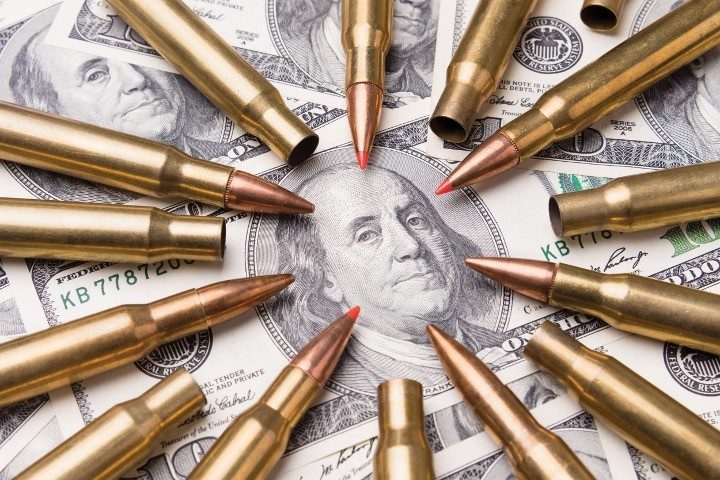
President Joe Biden has proposed the largest-ever military budget, asking the U.S. Congress for $813.3 billion in the coming year, which is $31 billion more than the budget for 2022. According to media reports, lawmakers are likely to increase the funding even more, as representatives from both parties voiced their concerns over record-high inflation.
Announcing his budget proposal Monday, the president said, “I’m calling for one of the largest investments in our national security in history, with the funds needed to ensure that our military remains the best-prepared, best-trained, best-equipped military in the world.”
According to Politico, while the budget request is “the largest ever in dollar terms,” a current inflation rate translates it into a 1.5 percent real increase compared to the previous year. This “will enrage many in Congress who have pushed for a 5 to 7 percent increase, citing Russian aggression and continued Chinese military modernization efforts,” noted the outlet.
The Biden draft seeks $773 billion for the Department of Defense (DOD) alone. The remaining $40.3 billion would be sent to the Department of Energy, which maintains the nation’s nuclear arsenal.
The DOD funding is aimed at enabling the department “to make the investments necessary to execute the Administration’s Interim National Security Strategic Guidance [INSSG] and forthcoming National Security Strategy and National Defense Strategy,” per the proposal.
In terms of foreign policy, the INSSG focuses on developing international diplomacy and bolstering international partnerships, alliances, and institutions.
The first point of Biden’s budget says the proposal “Supports the United States’ European Allies and Partners,” which echoes a globalist agenda of strengthening supranational institutions such as NATO.
“The Budget supports Ukraine, the United States’ strong partnerships with North Atlantic Treaty Organization (NATO) allies, and other European partner states by bolstering funding to enhance the capabilities and readiness of U.S. forces, NATO allies, and regional partners in the face of Russian aggression.”
Despite the administration’s heavy focus on the conflict between Ukraine and Russia, the budget implies that it is China that poses the greatest security threat to the United States, and calls it the “pacing challenge.”
“Even as we confront Russia’s malign activities, the defense strategy describes how the department will act urgently to sustain and strengthen deterrence with the [People’s Republic of China] as our most consequential strategic competitor and pacing challenge. The PRC has the military, economic and technological potential to challenge the international system and our interests within it,” said Deputy Secretary of Defense Kathleen H. Hicks when commenting on the budget proposal.
Stars and Stripes suggests that the budget does not appear to be a response to the Russian invasion of Ukraine, since the draft was largely finished before it happened.
What would the DOD spend the money on specifically?
Personnel
According to the DOD, the proposed budget “aims to cultivate our military and civilian workforce, grow our talent, build resilience and force readiness, and ensure accountable leadership.”
That includes, among other propositions, a 4.6% pay increase for military and civilian personnel (the largest in 20 years); funding a $15 per hour minimum wage for the federal workforce; $479 million to implement the recommendations of the Independent Review Commission on Sexual Assault in the Military; talent management initiatives to improve racial and gender diversity at “key points in the military career life cycle”; $34 million to improve the department’s capability to deter, detect, and address “concerning behaviors” and “extremism in the ranks”; and more.
Many of these points would contribute to soaring inflation, but that doesn’t seem to bother the department.
Military
The proposal asks for new investments in the nuclear triad and missile defense.
Nuclear modernization is slated to get $34.4 billion. Big-ticket purchases include one COLUMBIA-class ballistic missile submarine ($6.3 billion), two Virginia-class submarines ($7.3 billion), more funding for the development of Northrop Grumman’s B-21 bomber ($5 billion), and 61 F-35 jets from Lockheed Martin.
The draft also asks for $24.7 billion for missile defense programs, and another $27.6 billion for space missile warning, missile tracking, and space launch efforts.
Joint Force Readiness would receive $134.7 billion. A lion’s share of the funds would be sent to the Navy ($47.4 billion). Then there’s the Air Force ($35.5 billion); the Army ($29.4 billion); Special Operations Command ($9.7 billion); the Marine Corps ($4.1 billion); Joint Capabilities ($5.6 billion); and Space Force ($3.0 billion).
The budget also includes $10.3 billion for “Campaigning.” Of that, $6.1 billion would go to the Pacific Deterrence Initiative (almost double the $3.6 billion requested in 2022), and $4.2 billion would go to the European Deterrence Initiative, including $300 million in assistance to Ukraine.
A total of $130.1 billion is requested for research and development (known as RDT&E), a program that enhances acquisition and mission execution by helping transition new technologies into the services’ operational forces. This is also the highest figure on record, increasing by 9.5 percent from 2022.
Miscellaneous
In addition to that, the DOD wants to spend $3.1 billion on addressing the “climate crisis.”
The department also plans to continue to “build pandemic preparedness,” which would include $188 million on a Defense Health Program for continued Covid-19 clinical testing and public health efforts and $280.4 million on Chemical and Biological Defense Programs. An unnamed sum would go to “expanded surveillance activities, including wastewater surveillance Whole Genomic Sequencing of Covid variants.”




